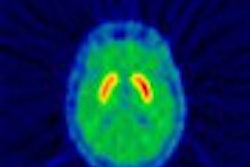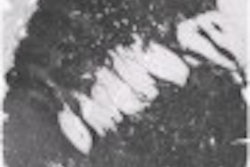SAN ANTONIO - Practices considering the addition of PET services in the U.S. soon learn that there is little incentive to offer more than a limited interpretation of the exam. The professional component of PET studies is currently being compensated at approximately 3%-4% of the total reimbursement, which works out to approximately $73-$81 per patient. On the other hand, the technical component contributes between 96%-97% of total reimbursement, some $1,750 to $2,400 per exam depending on the region in which the study is conducted.
"Because the reimbursement on the professional component of PET is ridiculously low, if a facility is considering offering PET services it really needs to have the technical component as part of its billing to make it worthwhile," explained Michael Bohl during a presentation Monday at the Radiology Business Management Association (RBMA) summit.
Bohl, who is the CEO of P2P Medical Management and administrator for Radiology Group and Mississippi Valley PET Imaging Center in Davenport, IA, shared his experience with creating a successful financial model for PET imaging.
Bohl’s PET strategy involved a thorough financial review that included payor reimbursements, break-even requirements, fixed and variable costs, a sensitivity analysis, and an examination of cash-flow issues. For his reimbursement review, he used the current Medicare rates for PET as published by Noridian Administrative Services for Iowa.
"I chose to use a conservative reimbursement option on which to base my forecasting," he said.
Because Bohl had the advantage of having an existing facility in place, adding PET to the modality mix was relatively seamless. Bohl said he did not have to factor in land costs, parking areas, a receptionist area, waiting area, film and file storage area, or a phone system into his calculation. Alterations to the existing structure were limited to remodeling an 800-square-foot (70 square meters) space to accommodate the scanner, control room, hot lab, quiet room, bathroom, and equipment room.
"The workspace is tight, but it’s easily manageable with just a nuclear medicine technician and a patient," he said.
For equipment, Bohl selected a bismuth germanate crystal (BGO) PET system. He looked at alternative technologies such as sodium iodide (NaI), lutetium oxyorthosilicate (LSO), combination PET/CT units, and purchasing a mobile PET system. The BGO system best met the investment capabilities of his group, and Bohl said he was able to negotiate a lease option for the unit.
After factoring in the reimbursement, equipment, and remodeling costs, Bohl created a net present value (NPV) break-even analysis of fixed versus variable costs. An NPV analysis is the present value of an investment’s future net cash flows minus the initial investment, he explained.
Fixed costs are those that generally don’t change with procedure volume. They include items such as lease payments, rent, and salaries. Variable costs are those that are affected by patient volume, such as FDG and film.
The analysis, based on an estimated 46 patients per month using the modality, established a break-even point for the investment at seven years, he said. When fixed costs, total costs, and revenues were included, the NPV analysis established that the facility could begin to have a positive cash flow on its investment at 50 PET patients per month.
"For the first year of operation, I didn’t add in maintenance contract fees for the system. However, these are substantial -- our contract is over $100,000 annually -- and need to be factored into the financial model from year two and on," Bohl said.
Using this information, Bohl then created a sensitivity analysis of his financial model to determine the effect of various factors on his forecasting. A sensitivity analysis is an investigation into how projected performance varies along with changes in the key assumptions on which the projections are based.
For Bohl, his key assumptions were FDG cost and use, patient volume, the PET system lease payment, reimbursement, and salary. After he plotted the analysis, he found that his projections would be most affected by changes in reimbursement and patient volume.
For the final piece of his model, Bohl created a graph of negative cash flow for the investment by comparing monthly volume against negative cash flow. His NPV analysis and negative cash flow analysis agreed with one another, with both projecting a break-even point of approximately 46 PET patients per month.
Bohl said there are other elements that need to be taken into consideration for a complete financial projection of a PET project. These include:
- A market evaluation of competing imaging centers and the area demographic.
- Local carrier policies regarding PET studies.
- The length of time needed for reimbursement from carriers.
- The education of staff regarding the new modality.
- Whether to dedicate staff solely to the modality.
- Marketing of the new service.
Bohl also cautioned prospective PET service providers to check the licensing regulations in their region, and the amount of time needed to obtain a certificate to operate. For example, one session attendee said it currently takes six months to receive licensure in Texas.
Bohl has made his PET modeling tool available via the RBMA Web site. The file can be found under the heading ACR Annual Meeting PET Presentation PET Modeling Tools. A left click on the heading will open a Microsoft Excel spreadsheet that can be saved to the viewer’s computer. A right click allows the viewer to save the file directly to a local disk drive.
By Jonathan S. BatchelorAuntMinnie.com staff writer
May 22, 2003
Related Reading
PET can assess efficacy of cancer treatment, May 10, 2003
PET outperforms CT in breast cancer staging, May 7, 2003
AC-PET goes one better than FDG for recurring prostate cancer, April 28, 2003
PET/CT growth sparks gains in U.S. PET market, April 15, 2003
PET/CT boosts confidence in rectal cancer staging, US yields high sensitivity, April 3, 2003
Copyright © 2003 AuntMinnie.com



















